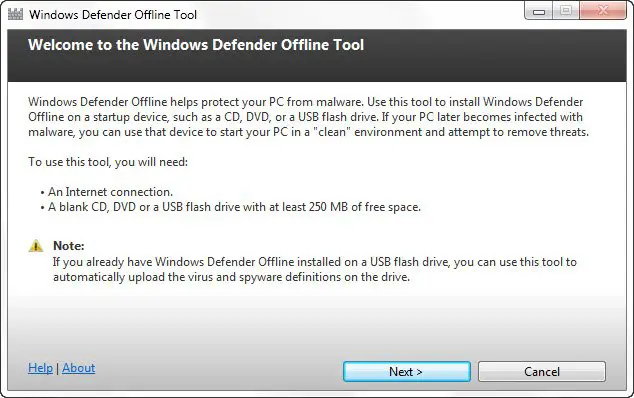Microsoft has released a new tool called Windows Defender Offline Tool. While most other security tools remove malware after Windows has started, they cannot remove some hard-to-remove malware like Rootkits, as they activate their malicious code before the Windows operating system starts.
Windows Defender Offline can be saved to removable media like a CD, DVD, or USB drive and can be booted from it to start the scan. It was earlier called Microsoft Standalone System Sweeper.
Sometimes, malware or potentially unwanted software installs themselves on your PC, when you are installing some software or when you visit unsavory websites on the Internet. Windows Defender Offline can help remove such hard-to-find malicious programs. Armed with definition files, Windows Defender Offline can detect such malicious and potentially unwanted software, and then notify you of the risks.
UPDATE: Windows Defender in Windows 10 now allows you to conduct an Offline Scan, that can help you get rid of persistent and difficult-to-remove malware and malicious software, using the latest threat definitions. You can perform a Windows Defender boot-time scan with the Offline Scan feature in Windows 10.
Windows Defender Offline Tool

To use Windows Defender Offline Beta, you need to follow the following steps:
- Download Windows Defender Offline and create a CD, DVD, or USB flash drive. You can also first download the ISO file to your disk.
- Restart your PC using the Windows Defender Offline media.
- Scan your PC for malware.
- If any are found, Windows Defender Offline will inform you.
- Remove the malware found from your PC.
- It is important always to have the most up-to-date definitions installed in Windows Defender Offline Beta, and so to download it only when you need it so that it has the latest definitions.
Download Windows Defender Offline Tool from Microsoft.
I have not downloaded it. But I have noticed that although Windows Defender Offline Tool and Microsoft Standalone System Sweeper Tool, both sport different icons and create download folders for the ISO under different names, they have an identical size of the ISO file and the Help links point to the same page. So it does look like there has been a name change.
Looks similar to standalone system sweeper tool
vasudevg.blogspot.com/2011/06/bootable-free-malware-cleaner-from.html
Yes as you also said looks similar to sweeper beta. The link provided earlier just for screenshots.
It does look like there has been a name-change. Although this Microsoft Answers thread also does not say anything: http://answers.microsoft.com/en-us/protect/forum/protect_start/what-is-windows-defender-offline-beta/ed85361a-0f68-458a-b2e5-fd504b58b54c?tab=MoreHelp
Actually it has the same GUI as the recently released Microsoft Security Essentials 4.0 Beta with fewer “Settings” (ie. Excluded Files and Locations, Excluded File Types and MAPS membership options) The Antimalware Client version (4.0.1111.0) is the same as is the Engine version (1.17903.0) On an XP machine with 756MB RAM it took under 15 min. to create a CD and about 12 min. to boot and scan 32,000 items. (scan time <9 min.) The MSSSTool used the old Windows Defender GUI. The bootable CD cannot be updated but a USB flash drive can so no need to make another coaster, use a flash drive. Of note is that the RAM requirement is down to 512MB making it more advantageous for those with older XP computers. Also noteworthy is that unlike most betas this is available through Windows Help and How-To as opposed to MS Connect. An interesting discussion is underway,
http://answers.microsoft.com/en-us/protect/forum/protect_start/lets-confuse-the-user-as-much-as-we-possibly-can/11901f6f-bbe1-42fb-b98b-fe303b7ab5d2
Thanks for the link Quincy. Well, lets hope Microsoft clears this up soonest.
You’d think that Microsoft would get the wording right. See the screen shot about “If you already have WDO installed on a USB….” The text should say, “… automatically **UPDATE** the definitions” (Not UPLOAD them)